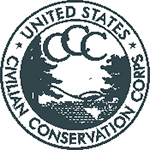History of Laurel Hill State Park
The Laurel Hill Valley escaped the unbridled logging that swept through Pennsylvania far longer than many areas of the state. The steep stream valleys and rugged hills made logging difficult until technology laid the tracks to enable the trees to be hauled to mills.
Powerful, slow locomotives climbed the switchback tracks through Laurel Hill and hauled the logs to mills. From 1886 to 1940, logging companies clear-cut the trees of the park, leaving behind a wasteland of brambles prone to forest fires and flooding. Only the area now called Hemlock Trail Natural Area escaped the loggers’ reach.
The CCC

Beginning in 1935, the Federal Emergency Relief Administration began purchasing sub-marginal agricultural and forest land so that it could be converted to better use. In 1936, the National Park Service was given the responsibility of the Recreational Demonstration Areas.
Laurel Hill was one of five areas in Pennsylvania that was targeted for restoration and reforestation, organized group camping, and day picnicking.
Beginning in 1935, with cooperation of the Pennsylvania Department of Forests and Waters, men of the Works Progress Administration (WPA) and the Civilian Conservation Corps (CCC) began building roads, trails, bridges, and recreational facilities.
Two CCC camps, NP-5-PA and SP-15 arrived in July 1, 1935 and began building camps for themselves (currently Group Camp 8 and Group Camp 5). The 200 young men in each camp worked year-round building park facilities like group camps, picnic areas, waterlines, roads, the beach house, and Laurel Hill Lake. World War II ended the CCC.
In October of 1945, the Department of the Interior transferred the project to the Commonwealth of Pennsylvania and it became Laurel Hill State Park.
The Laurel Hill Recreational Demonstration Area Historic District includes all CCC-constructed buildings and structures that retain a significant degree of integrity. The district contains 202 buildings on 1,352 acres of land, which is the largest collection of CCC architecture in Pennsylvania state parks.